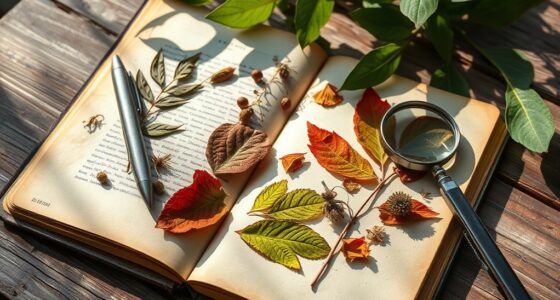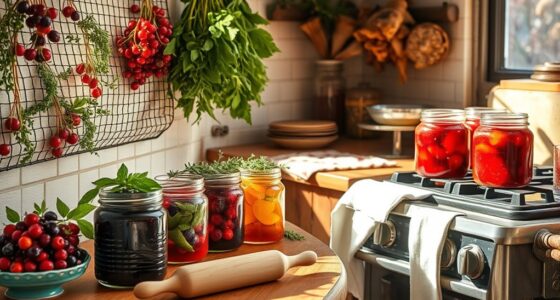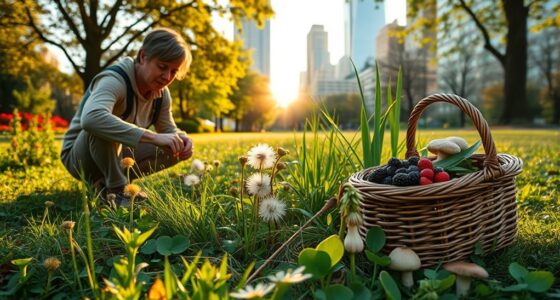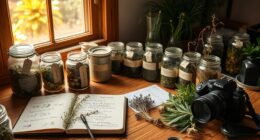You're about to uncover the hidden gems of Idaho's wilderness, where wild delicacies await your discovery. From forests to urban parks, Idaho offers diverse habitats for foraging. To guarantee a safe and enjoyable experience, identify plants accurately, adhere to local regulations, and forage responsibly. Idaho's wilderness is home to unique plant species, including huckleberries, morel mushrooms, and wild herbs like yarrow and sage. As you explore, you'll discover an abundance of wild foods, with new delicacies emerging each month. As you venture further, you'll uncover the secrets of Idaho's foraging hotspots and the art of sustainable harvesting.
Key Takeaways
- Idaho's diverse landscapes, from forests to urban parks, offer ideal environments for foraging wild edibles.
- Accurate plant identification and adherence to local regulations are crucial for a safe and legal foraging experience.
- Idaho's wilderness is home to a wide variety of wild delicacies, including huckleberries, morel mushrooms, and wild herbs like yarrow and mint.
- Seasonal foraging in Idaho's wilderness provides a dynamic experience, with new wild edibles emerging each month.
- Responsible foraging practices, including sustainable harvesting and proper food handling, are essential for maintaining ecological balance and ensuring a safe foraging experience.
Idaho's Edible Wilderness Treasures
As you venture into Idaho's diverse landscapes, you'll uncover a treasure trove of wild edibles, from prized mushrooms and juicy huckleberries to unique plant species found only in the Gem State. Foraging in Idaho offers a unique opportunity to explore the state's vast wilderness and discover its hidden culinary gems.
From the forests to the countryside, Idaho's varied habitats provide the perfect environment for a wide range of wild edibles to thrive. As you wander through the state's picturesque landscapes, keep an eye out for wild mushrooms, berries, and other tasty treats waiting to be discovered. Urban settings, such as parks, can also provide unexpected foraging opportunities.
Whether you're a seasoned forager or just starting out, Idaho's edible wilderness treasures are sure to delight and inspire. By exploring the state's wilderness, you'll not only uncover new flavors and ingredients but also develop a deeper connection with nature.
Foraging Safety and Best Practices

Before you start foraging for Idaho's wild delicacies, it's important that you're aware of the safety guidelines and best practices to guarantee a fun and safe foraging experience. Foraging safety is key to enjoying the wild plants of Idaho's wilderness.
Here are some essential tips to keep in mind:
| Foraging Safety Tip | Why It Matters | Best Practice |
|---|---|---|
| Positively identify plants | Avoid misidentification and potential risks | Consult multiple field guides and expert opinions |
| Follow local regulations | Prevent legal issues and environmental harm | Research local laws and regulations |
| Forage responsibly | Preserve ecological balance and environment | Take only what you need, leave some for others |
| Wash and cook foraged foods | Eliminate potential contaminants | Wash thoroughly, cook to recommended temperatures |
Identifying Wild Delicacies in Idaho

With its diverse landscapes, Idaho offers you a vast array of wild delicacies to discover, from sweet huckleberries to savory morel mushrooms. As you venture into Idaho's wilderness, you'll find an abundance of wild foods waiting to be foraged. From the tender shoots of miner's lettuce to the pungent flavor of wild onions, the state's varied landscapes provide ample opportunities to discover unique and flavorful wild delicacies.
You can also forage for wild herbs like yarrow, mint, and sage, which are perfect for adding a touch of freshness to your culinary creations. As you explore Idaho's wilderness, keep an eye out for chokecherries, whose tart flavor makes them a perfect addition to jams and preserves. Remember to always identify wild delicacies correctly and harvest them sustainably to guarantee their continued availability.
Seasonal Foraging in Idaho's Wilderness

You'll find that Idaho's wilderness transforms into a dynamic foraging ground throughout the year, with new wild delicacies emerging each month. As you spend time in nature, you'll discover that the season dictates what's available to forage.
In January, you might find cedar, holly, and ivy, while May brings beech, cherry, and oak. This variation keeps your foraging adventures exciting and unpredictable. You'll need to adapt to the changing landscape, learning what's in season and where to find it.
By embracing this seasonal approach, you'll develop a deeper connection with the natural world. You'll come to appreciate the unique characteristics of each season and the wild delicacies they bring. As you explore Idaho's wilderness, remember to practice responsible foraging, ensuring that you leave enough for the local wildlife and only harvest what you need.
Exploring Idaho's Foraging Hotspots

As you venture into Idaho's wilderness, pinpointing the state's foraging hotspots becomes crucial to reveal the hidden gems of wild edibles. Idaho's diverse topography offers a range of habitats for foraging, from forests to mountains and even urban settings like parks.
You'll find that forests are particularly rich in wild edibles, with mushrooms, huckleberries, and various edible plants waiting to be discovered.
When exploring Idaho's wilderness, keep an eye out for areas with rich soil and adequate moisture, as these conditions often produce the most abundant and diverse wild edibles. Be sure to follow responsible foraging practices to safeguard the environment and ensure the sustainability of these wild food sources. Additionally, carrying a field guide or using a reliable app can help you correctly identify plants and avoid any harmful or poisonous species. Whether you’re in Idaho or foraging wild edibles in Utah, always harvest in moderation and rotate pickings among different areas to minimize your environmental impact. This way, you can help preserve nature’s bounty for future generations while enjoying the diverse flavors these ecosystems offer.
As you explore, take note of the changing seasons, which bring new opportunities to discover different wild edibles. From cedar and fir in January to elderflower and oak in May, Idaho's varied seasons offer a range of wild edibles for you to uncover.
Frequently Asked Questions
How to Forage for Food in the Wilderness?
You'll start by identifying edible plants specific to the environment you're in, then practice responsible foraging by taking only what you need, respecting the land, and properly washing and cooking your finds to guarantee a safe and delicious meal.
What Can I Forage in Idaho?
"When you're in the right place at the right time, you strike gold – and in Idaho, that means foraging for wild mushrooms, huckleberries, and herbs, depending on the season and where you roam!"
What Are the Foraging Laws in Idaho?
You need to know Idaho's foraging laws: get permission for private lands, respect designated areas on public lands, and research regional rules to avoid fines or legal consequences for violating protected species or areas.
How Do You Forage in the Wild and Identify Edible Plants?
You'll start by researching edible plants, then head outdoors to identify them using field guides or expert guidance, and finally, you'll harvest responsibly, ensuring a safe and sustainable foraging experience.
Conclusion
As you venture into Idaho's wilderness, the thrill of discovery awaits. You've traded concrete for canopied trails, and the sweet scent of wild berries for the hum of city streets. With every step, the possibility of unearthing a hidden delicacy grows.
Remember to respect the land, respect the seasons, and respect the art of foraging. Idaho's wilderness wonders are yours to savor – go forth and forage!










